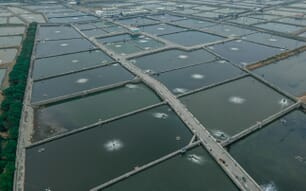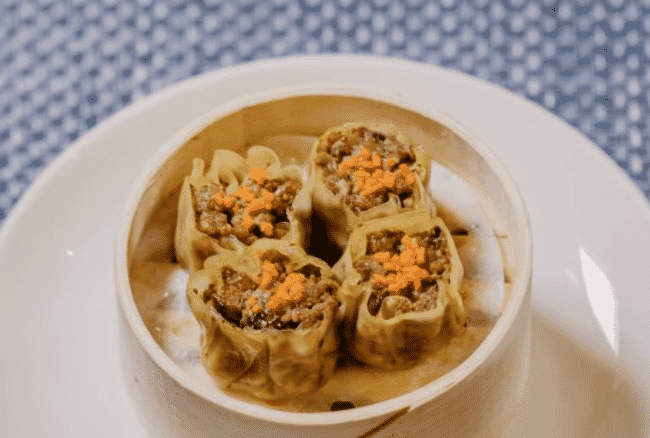
Continuing innovations and reaching price parity could make Asia's alternative seafood sector dominant © Shiok Meats
Alternative seafoods have begun to make a presence in Asian markets but not much is known about their current market share, the increasing involvement of big businesses and governments, and the long-term prospects for growth in the region. Highlighting the production initiatives and multi-million-dollar investments that are already taking place in several Asian countries such as Singapore, Japan, Thailand and Hong Kong, it is possible that continued innovations as well as price parity with traditional seafoods will be the main drivers in making Asia’s alternative seafood sector dominant.
Seafood, either from the wild or through aquaculture, has always been a traditionally important protein source. As per the FAO’s The State of World Fisheries and Aquaculture (SOFIA) 2022 report, total fisheries and aquaculture production reached a record of 214 million tonnes in 2020 which includes 178 million tonnes of aquatic animals and 36 million tonnes of algae. Per capita consumption of seafood in 2020 was 20.2 kg and global consumption has increased at an average annual rate of 3 percent since 1961. The seafood business globally is doing better when compared with other food industries; however, overexploitation of some commercial species, increased environmental pressure and higher standards of fish welfare have given scope for the birth of a new segment which can be termed as “alternative seafood”. Globally, there are about 100 companies which are involved in this segment.
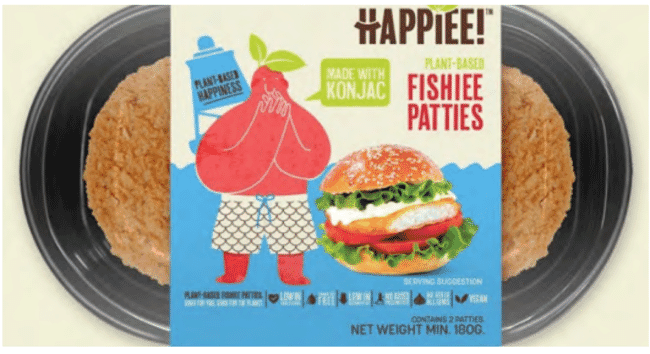
Plant-based seafood companies are creating products that mimic the taste, texture, appearance and/or nutritional properties of conventional seafood
Alternative seafood, which is emerging as a new source of food with the potential to augment future food supplies, mainly comprises all plant-based, fermentation-derived and cell-based seafood forms that mimic the taste, texture, appearance and/or nutritional properties of conventional seafood. Plant-based seafood is a combination of the following ingredients: legume proteins, soy protein, wheat protein, rice, vegetables, mycoproteins, seaweed, algae and/or plant oils. Cultivated or cell-based seafood is based on the isolation and multiplication of stem cells (capable of differentiating into many cell types) or immortalised cell lines (differentiated muscle, fat, connective tissue cells that continue to propagate) from aquatic animals (Benjaminson et al. 2002). The third category, fermentation-derived seafood, is produced through various techniques of fermentations.
Currently the alternative seafood segment has a bigger footprint mainly in the US, but with growing awareness in Asia, a strong pool of talent and innovation, willingness by governments to support the segment on regulatory grounds, involvement from business giants, the upgraded status of universities and research support systems, Asia is likely to assume dominance in the next few years. Plant-based seafood is now available for consumption in some regional markets, fermentation-derived seafood has a niche presence in China, and cell-based seafood is on its way to entering the commercial market next year as per announcements from some companies. Millions of dollars have been attracted by leading alternative seafood companies in Asia, a trend which has become more obvious over the last three years.
The prices are, and will be, higher for alternative seafood in comparison with traditional seafood products for some years from now, and one may expect decreases in the price per unit with an increase in scale. Several factors – taste, health benefits, the desire to reduce carbon emissions, well-developed labelling frameworks, quality, the promise of lower prices with increasing volumes, innovations – will drive consumption of these novel foods strongly in the future.
Plant-based seafood alternatives in the market
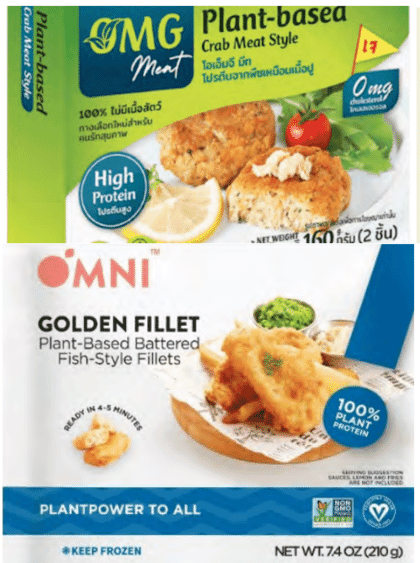
Thai Union, one of the largest seafood manufacturers in the world, launched a plant-based seafood range called “OMG Meat” in 2021
Plant-based seafood now has a presence on the shelves of various supermarkets in Asia. Thai Union, one of the largest seafood manufacturers in the world, launched a plant-based seafood range called “OMG Meat” in 2021. The products they offer are plant-based tuna, plant-based crab meat, plant-based fish nuggets, plant-based crab dumplings and recently in August 2022, plant-based shrimp dumplings (wontons) were released nationwide in Thailand. For most of the products, the major plant-based ingredients used are soy and wheat protein. This popular brand can be seen in 18 provinces covering 58 districts through 18 online/offline sales channels via e-commerce and modern trade stores in Thailand.
The startup Growthwell Foods in Singapore carries its plant-based seafood portfolio through the “HAPPIEE!” brand. It has plant-based fishiee sticks and fishiee patties in its retail range which includes breaded fishiee patties, fishiee nuggets, breaded crabbie patties and salmoniee flakes. The products are based mainly on the ingredient konjac. Products under this brand are spread across more than 92 supermarket stores, mainly in the NTUC supermarket chain, and also at Cold Storage, Hao Mart and PRIME outlets. Leading e-commerce players Amazon, Red Mart and Fair Price offer products under the brand and it is also available at some 70 cafés and restaurants across Singapore.
In 2021, the US-based Gathered Foods brand Good Catch launched plant-based food service tuna, plant-based fish burgers and fish cakes, as well as plant-based crab cakes in the Singapore market. Good Catch uses a blend of peas, chickpeas, lentils, soy, fava beans and navy beans, with an umami flavour from seaweed and algae extracts to make a product that looks, tastes and “behaves” like tuna fish. It is now available across multiple food service outlets in Singapore and also in high-class premium restaurants like the one at the Grand Hyatt Singapore and Privé. Gourmet casual outfits like Love Handles and delivery-only concepts like Good Food People now also make Good Catch products available. Liang Yi Food Industries of Singapore is an online vegetarian supermarket which has a good portfolio of plant-based seafood products.

Good Catch uses a blend of peas, chickpeas, lentils, soy, fava beans and navy beans, with an umami flavour from seaweed and algae extracts to make a product that looks, tastes and “behaves” like tuna fish © Good Catch
Hong Kong-based Green Monday’s Omni Food launched its Omni Seafood series on World Ocean Day (8 June) in 2021. The product range includes Omni Classic Fillet, Omni Golden Fillet, Omni Ocean Burger, Omni Tuna and Omni Salmon. Omni Food has a distribution across 40 000 sale points and can be found in some 20 countries. The organisation has a strong presence in Asia along with US, Europe and the UK. Omni Seafood is made from a proprietary blend of non-GMO soy; the company states that it has zero cholesterol, is free from trans-fat and has no added preservatives, hormones or antibiotics. Omni Tuna is the first ambient product in the Omni Seafood series – it can be kept at room temperature and the shelf life is about two years from the date of manufacture. This quality makes the product unique from the other alternative seafood products. Omni Seafood has a presence in Hong Kong and Singapore; in August 2022, it was introduced into the UK’s Whole Foods market in London, online at Ocado and The Vegan Kind Supermarket.
Various Japanese supermarkets also carry Omni Tuna products. Azu Marche has launched a plant-based seafood brand called Green Surf for Japanese customers whereas Diaz Inc and Next Meats produce alternative tuna. Plant-based seafood is mainly sold in Japan through online platforms although some physical stores also carry the range.
In Spain, Mimic Seafood has launched an eel alternative called Aubergeel which has Japanese eggplant as its main ingredient. The product is seasoned with Asian-style ingredients such as soy sauce, rice vinegar, mirin, sake, and sesame oil.
Israel-based startup Plantish is putting efforts into producing plant-based salmon but this is still being improved upon and the product has not yet hit the market commercially. Meanwhile, SeaSpire, a clean label Indian alternative seafood start-up, has announced its whole-cut snapper alternative which is made using seven plant-based ingredients using its proprietary bio-printing platform. The company claims to be the first of its kind to produce bio-printed whole-cut whitefish products in the Asia-Pacific region and is planning to enter the market soon. There are many other startups working on plant-based seafood in different countries of Asia which may be expected to be seen in the coming years.
Cell-based seafood
The core concept behind this method is the tissue regeneration process, which naturally occurs in all animals; tissues renew themselves by reproducing cells to repair and maintain overall health. Cell-based seafood replicates this process under controlled conditions. If this nascent technology scales, it would alleviate pressure on oceans, lakes and rivers. This process brings many advantages, an important one being less usage of resources when compared with conventional seafood production. This method avoids the usual production of byproducts (trimmings, bones etc) and produces only the desired seafood. Various reports have mentioned that this method is also useful in substantially lowering GHG emissions.
Cultivated meat/seafood begins with taking a number of cells from an animal and nurturing them in a nutrient-rich, animal-free growth medium, where they are capable of multiplying. Subsequently, the cells can be stimulated to differentiate into muscle, fibre, or fat cells, and through tissue engineering techniques supporting the three-dimensional organization of the cells, a tissue is grown that mirrors that which is traditionally produced.
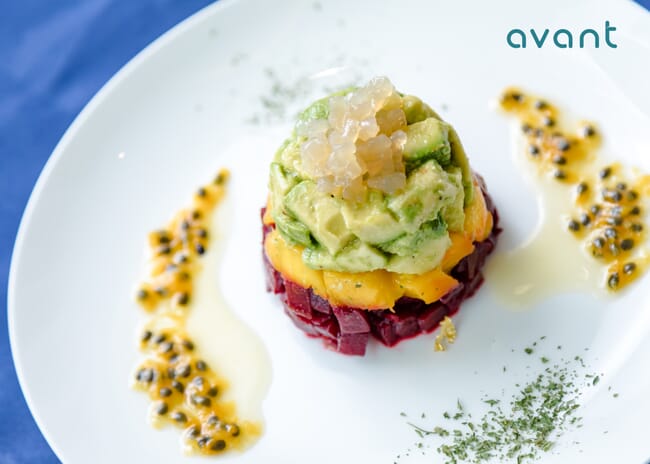
If cell-culture technology scales, it would alleviate pressure on oceans, lakes and rivers © Avant Meats
Singapore-based Shiok Meats is the leading name in the cell-based seafood category. The startup has developed cell-based shrimp dumplings, lobster meat, crab meat and is working meticulously to launch cell-based shrimp commercially for the first time by 2023 at $50/kg. Umami Meats (Singapore) has experimented with a legume-derived growth serum and conducted lab trials to grow the cells of Japanese eel and yellowfin tuna. The company’s next step is to create the first prototypes of a product and to develop a production system around its serum.
Avant Meats (Hong Kong) is the first biotechnology company which has announced plans to tap into the market for alternative fish maws, one of the most popular seafood items in China. In South Korea, CellMEAT has successfully made a prototype of dokdo shrimp in 2022. According to Mr Kim of CellMEAT, the pink-coloured dokdo shrimp can only be found in the Arctic Ocean and the seas of Japan. He added that the shrimp is considered a delicacy and is sold at around USD 160/ kg whereas they are aiming to market their cell-based dokdo shrimp for under $5/kg. CellMEAT plans to distribute its cultured dokdo shrimp products throughout Korea, Singapore and the US by 2024.
Several Israeli companies are also worth mentioning: (i) Forsea aims to produce cell-based eel because of its commercial value. A kilogram of eel in Japan sells for $60 and smoked eel or vacuum-packed eel sells for €50 per kilogram in Europe; (ii) Using R&D facilities in the US and Israel, Wanda Fish has established a proprietary, GMO-free platform for producing cell-based finless fish fillets of varying species; and (iii) E-FISHient Protein is working on cell-based tilapia.
Fermentation-derived alternative seafood
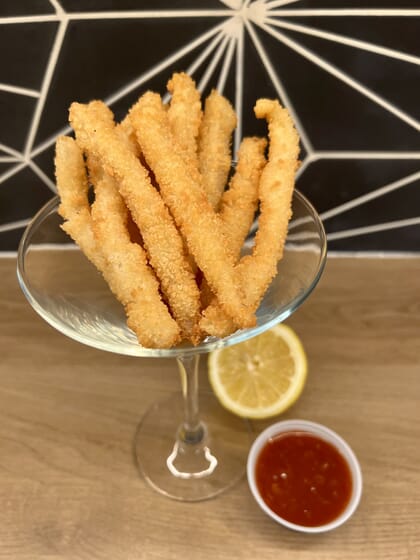
Alternative seafood companies have worked with traditional processes for producing fermentation-derived seafood products © Aqua Cultured Foods
There are three basic types of fermentation, namely traditional fermentation, biomass fermentation and precision fermentation. So far, alternative seafood companies have worked with traditional processes for producing fermentation-derived seafood products. Hong Kong-based New Singularity Limited has developed a technology which uses plant algae as a fermentation substrate to produce mycelium with a shrimp flavour, as well as mushroom hyphae mixed with peas and rice which gives rich flavour, stronger water binding ability and high protein content. In 2020, New Singularity had announced that plant-based shrimp will be launched in 100 000 deli stores in China by June 2021; however to date, recent updates are not available.
Mermade Foods is an Israel-based cellular aquaculture company which aims to bring a novel approach in the production of scallop analogues using a recyclable fermentation-based process. The technique upcycles spent cell growth media by feeding it to microalgae to produce algal biomass. This new algal biomass can then be fed back to the cells, thus reducing or eliminating waste and lowering input costs.
Investments and partnerships
Millions of dollars have been invested in Asian alternative seafood companies since the last few years. In January 2021, Thai Union invested in Californian cell-based seafood startup BlueNalu through its corporate venture fund. Additionally, Thai Union Group PCL and V Foods (Thailand) Co, Ltd signed a Memorandum of Understanding in June 2021 for the production of V Foods’ existing and new range of plant-based products using Thai Union’s manufacturing facilities. In July 2021, Thai Union announced that its Corporate Venture Capital (CVC) Fund had joined other industry-leading strategic and financial partners investing in Israel-based cell-based company Aleph Farms’ $105 million Series B fundraising round.
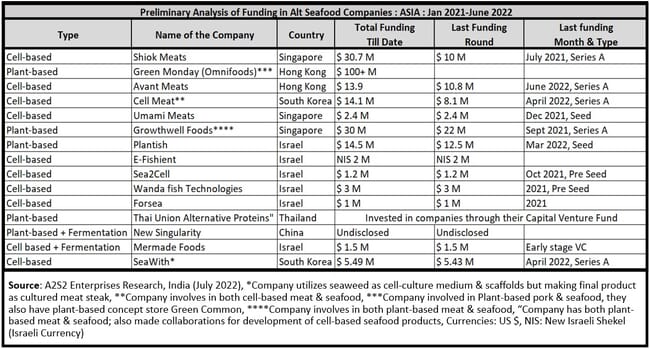
On 26 April 2021, Avant Meats announced its intention to establish pilot manufacturing facilities in Singapore with the support of the Singapore Economic Development Board (EDB). On 20 September 2021, A*STAR Bioprocessing Technology Institute (Singapore) announced its collaboration with Avant Meats to accelerate cultivated fish technology for the mass market. Avant Meats was the only alternative seafood company to join World Economic Forum’s Technology Pioneer community among the top 100 global startups in the 2021 cohort.
Another major 2021 investment was in July when Vietnam’s largest seafood exporter Vinh Hoan invested in Singapore’s Shiok Meats. In December the same year, the latter officially inaugurated a mini-plant in Singapore with advanced R & D facilities to achieve scaling-up of its production on the commercialisation of cell-based shrimp.
The alternative protein pioneer, Hong Kong-based Green Monday, announced a partnership with global coffee company Starbucks in November 2021, and as a part of that collaboration, Omni Crab Cake has been launched in 250 outlets of Starbucks Hong Kong. The Omni Seafood range has been available in Green Common vegan grocery stores since June 2021; it has also attracted the restaurant segment in Hong Kong which includes the upscale hotel Cordis Hong Kong and the Michelin-starred Chinese restaurant Ming Court Wanchai, which promised to use the products for making innovative dishes from July 2021.
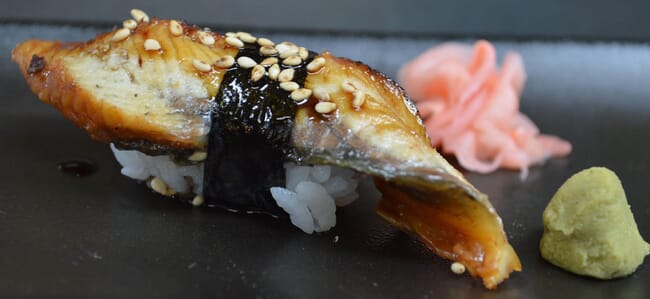
Singapore’s Umami Meats began to collaborate with Israel-based MeaTech to utilise their 3D printing capabilities in 2022 © Umami Meats
Moving on to 2022, during the first half of the year there has been an investment of over $31 million in alternative seafood companies. In January, Japan’s largest sushi restaurant operator, Food & Life Companies (F & LC), announced a partnership with California-based cell-based seafood startup BlueNalu. F&LC operates restaurant brands including Sushiro and Kyotaru, managing over 1,000 restaurants in Japan, Korea, Taiwan, Hong Kong, Singapore, Thailand and China. Japan’s Mitsubishi Corporation, Sumitomo Corporation and South Korea’s Pulmuone have also signed a MoU with BlueNalu.
This year’s largest investments so far were in March when Israeli company Plantish successfully raised $12.5 million followed by Avant Meats which closed a round of $10.8 million through a Series A funding round in June 2022. Another Israeli food-tech startup called Wanda Fish Technologies announced an agreement with Tufts University in April 2022 for advanced research into the development of cultivated (cell-based) fish as a food item.
In July 2022, Vietnamese shrimp processor Minh Phu Seafood signed a Memorandum of Understanding with Shiok Meats to set up a joint research and development facility in Vietnam. Also in July 2022, to build the technology platform for cultivating fish muscle and fat in order to produce a variety of structured products, Singapore’s Umami Meats began to collaborate with Israel-based MeaTech to utilise their 3D printing capabilities.

Their fish fingers and fish balls made from cultivated fish cells are expected to be introduced into Singapore by the end of 2023 while applying for approval in other developed markets © Bluu Seafood
The latest development as at the time of writing was noted in August 2022, when German cell-based seafood startup, Bluu Seafood, presented the first market-ready products made from cultivated fish cells. Their fish fingers and fish balls made from cultivated fish cells are expected to be introduced into Singapore by the end of 2023 while applying for approval in other developed markets. Bluu Seafood also has a collaborative arrangement with cell-based meat entrepreneur CellX (China) since April 2022.
Some major challenges
The biggest challenges faced by the alternative seafood industry presently are the higher cost of production, perfecting the taste of the food and scaling up the production. Various surveys have suggested that the taste of plant-based seafood is good but that it needs to be a closer match to traditional seafood; companies are therefore investing further in research to make the improvements.
For cell-based food products, the most common cell growth medium is foetal bovine serum (FBS), a laboratory-grade compound derived from the blood drawn from a bovine foetus taken from a slaughtered cow at an abattoir. FBS can cost as much as $2,960 per litre and companies are working to develop less expensive and animal-free sources of cell growth media as well as cultivation techniques that require lower quantities of cell growth media. Additionally, bioreactors have an upper volume limitation of 20,000 litres that produces a small amount of cultivated meat and any modifications may require costly collaboration with biotech companies. As per company sources, with a multi-pronged approach and patent-pending methods, Avant Meats has achieved over 90 percent cost reduction with an animal component-free cell culture medium. Avant’s pilot plant in Singapore, which will utilise bioreactors of up to 2,000 litres in volume, will be in operation in 2023.
Another hurdle is related to consumer attitudes in Asia towards alternative seafood as few studies have been done to determine its acceptability. The most recent was a study commissioned by the Good Food Institute Asia Pacific in collaboration with Getwizer, involving a survey of one thousand residents each in Japan, Singapore, South Korea and Thailand. The major outcome of the study was that taste is the base factor for both plant-based and cell-based seafood in all four countries. Respondents in Thailand were more aware and would like to try more diverse alternative seafoods, whereas Japanese consumers showed more interest in plant-based seafood rather than cell-based seafood. One of the major barriers observed in all these countries was the perceived lack of “freshness” and “naturalness” of plant-based seafood products.

The regulatory framework in Asia
Singapore became the first country in the world to officially approve cell-cultured meat and seafood products in 2020. In 2019, the Singapore Food Agency (SFA) had introduced a novel food regulatory framework which includes pre-market assessment of novel food, monitoring and submission of safety assessments including toxicity, allergenicity, safety of production method and dietary exposure arising from its consumption. Singapore is therefore one of the fastest growing markets for alternative food products in Asia and globally, driven partly by its national “30 by 30” policy.
Other initiatives in Asia include: (i) China’s National Development and Reform Commission (NDRF) has included alternative protein in its agricultural policy objectives under the 14th Five Year Plan in 2022; (ii) The Food Safety and Standards Authority of India (FSSAI) introduced the “Food Safety and Standards (Approval of Non- Specified Foods & Food Ingredients) Regulation 2017 which covers novel food products/ingredients, as well as food and food ingredients processed with the use of novel technology; (iii) Thailand’s Ministry of Public Health has created a notification for “Novel Food” in 2016; (iv) In Japan, the Centre for Rule-making Strategies (CRS) has formed the Japan Association of Cellular Agriculture (JACA) which brings together more than 70 entities from industry, academia, business, media, and the authorities for the purpose of working closely on the aspects of cellular agriculture.
An important development has been the formation of the Asia Pacific Society for Cellular Agriculture (APAC-SCA) in March 2022, involving the leading 11 major Asian cell-based meat and seafood companies. Based in Singapore, the Society was formed with the intention of engaging with consumers, facilitating the development of regulatory frameworks, and advocating for a safe and sustainable future across the APAC region.
Asia’s export potential for alternative seafood to the US
There is no official data available for the export of plant-based seafood from Asia to the US. Quoting Maarten Geraets, managing director for alternative proteins at Thai Union, alternative seafood was worth $30-50 million on the global retail side in 2020. Plant-based fish and plant-based shellfish recorded retail sales of $10.4 million and $3.5 million respectively in the US market in 2021.
Companies from Asia have started exporting plant-based seafood products to the US. Green Monday’s Omni Seafood range is now available at the US online retailer GTFO It’s Vegan since July 2022. Its Omni Pork range was launched last year in the US at nearly 200 Whole Foods Market and all 371 Sprouts Farmers Market, so if the same support is extended for the Omni Seafood range, then that may drive huge sales for this category.
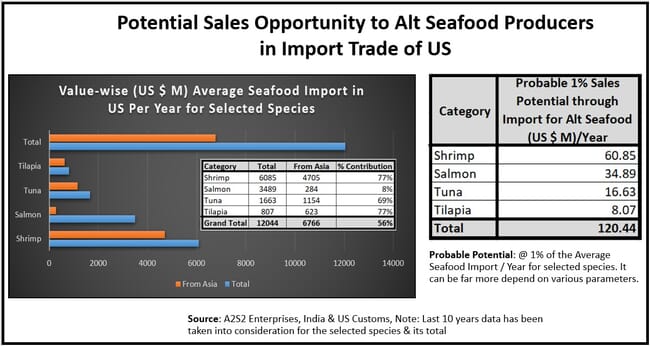
Thai Union, which is a strong player in traditional shrimp as well as tuna, has launched plant-based tuna successfully in 375 stores in Europe earlier this year (February 2022), followed by the launch of a plant-based protein range of seafood in the US market through collaboration with the ISH Food Company in August 2022. Meanwhile, collaborating with distribution chain SNOFOX (which operates sushi bars at 1,230 grocery locations in the US) may bring huge benefits to Asian alternative seafood players. This is similar to the partnership between the world’s largest fast-casual pork chain POKEWORKS and US cell-based startup Wild Type – putting similar efforts in may give leverage to alternative seafood producers from Asia.
Conclusion
The alternative seafood segment can complement traditional seafood business for the next few years and then it may create its own space as a major food category. Though scaling the production is a major challenge, this can be solved through deeper research. The most crucial point to take into consideration is establishing appropriate legal frameworks, an area in which countries in Asia have taken the lead. Plant-based seafood is witnessing growing volume sales, and with improvements on taste as well as comparable price levels, the sector may pick up at a faster pace. The involvement of all stakeholders (government, industry, academia, research institutes, businesses, political entities) may help the segment to expand, thus contributing towards feeding 10 billion people by 2050.




